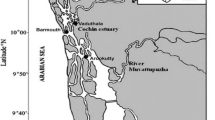Abstract
Seasonal changes in sedimentary microbial communities were investigated using biomarker analysis from samples collected in spring and autumn 1995 from Hiroshima Bay and Suo Nada of the Seto Inland Sea of Japan. Surface sediment samples were analysed for several sediment parameters and phospholipid ester-linked fatty acids (PLFA). Total PLFA concentration, which is indicative of microbial biomass, was high in autumn and low in spring in Hiroshima Bay but no such significant seasonal difference of PLFA concentration was observed in Suo Nada. PLFA composition of the sediments were dominated by saturated PLFA, branched PLFA and monounsaturated PLFA. Regional variation in the PLFA composition was less pronounced than the seasonal variation. The presence of the characteristic polyunsaturated fatty acids (PUFA) revealed that microeukaryotes were always present in small proportions. The aerobic prokaryotes and eukaryotes group were predominant in spring, whereas in autumn, the Gram-positive bacteria group was predominant. Monounsaturated PLFA/branched PLFA ratio was high in spring and low in autumn, indicating the relative dominance of these biomarker fatty acids. Significant seasonal differences of sediment parameters, PLFA groups and microbial groups were observed in Hiroshima Bay. In Suo Nada, these parameters showed similar patterns to Hiroshima Bay but the differences of most of the parameters were insignificant. Furthermore, principal components analysis (PCA) revealed a significant shift in microbial community structure between the two seasons, indicating a clear response of microbial communities to changes in sediment parameters.
Similar content being viewed by others
References
Baird, B. H. & D. C. White, 1985. Biomass and community structure of the abyssal microbiota determined from the ester-linked phospholipids recovered from Venezuela basin and Puerto Rico Trench sediments. Mar. Geol. 68: 217–231.
Findlay, R. H., M. B. Trexler & D. C. White, 1990. Response of a benthic community to biotic disturbance. Mar. Ecol. Prog. Ser. 62: 135–142.
Findlay, R. H., L. Watling & L. M. Meyer, 1995. Environmental impact of salmon culture on marine benthic communities in Maine: a case study. Estuaries 18: 145–179.
Frostegard, A., A. Tunlid & E. Baath, 1993. Phospholipid fatty acid composition, biomass and activity of microbial communities from two soil types experimentally exposed to different heavy metals. Apl. Envir. Microbiol. 59: 3605–3617.
Guckert, J. B., C. P. Antworth, P. D. Nichols & D. C. White, 1985. Phospholipid ester-linked fatty acid profiles as reproducible assays for changes in prokaryotic community structure of estuarine sediments. FEMS Microbiol. Ecol. 31: 147–158.
Haldman, D. L., P. S. Amy, D. Ringelberg, D. C. White, R. E. Garen, & W. C. Ghirose, 1995. Microbial growth and resucitation alter community structure after perturbation. FEMS Microbiol. Ecol. 17: 27–38.
JFRCA, Japan Fisheries Resources Conservation Association, 1980. Manual for water pollution analyses, Koseisha Koseikaku, Tokyo. (in Japanese): 256–260.
Mancuso, C. A., P. D. Franzmann, H. R. Burton & P. D. Nichols, 1990. Microbial community structure and biomass estimates of a methogenic Antarctic Lake ecosystem as determined by phospholipid analyses. Microb. Ecol. 19: 73–95.
Nichols, P. D., J. B. Guckert & D. C. White, 1986. Determination of monounsaturated fatty acid double-bond position and geometry for microbial monocultures and complex consortia by capillary GC-MS of their dimethyl disulphide adducts. J. Microbiol. Meth. 5: 49–55.
Okaichi, T. & T. Yanagi, 1997. Sustainable development on the Seto Inland Sea, Japan - From the viewpoint of fisheries. Terra Scientific Publ. Co., Tokyo, Japan, 329 pp.
Peterson O. S. & J. M. Klug, 1994. Effect of sieving, storage and incubation temperature on the phospholipid fatty acid profile of a soil. Apl. Envir. Microbiol. 60: 2421–2430.
Rajendran, N., O. Matsuda, N. Imamura & Y. Urushigawa, 1992. Variation in microbial biomass and community structure in sediments of eutrophic bays as determined by phospholipid ester-linked fatty acids. Apl. envir. Microbiol. 58: 562–571.
Rajendran, N., O. Matsuda, Y. Urushigawa & U. Simidu, 1994. Characterization of microbial community structure in the surface sediment of Osaka Bay, Japan, by phospholipid fatty acid analysis. Apl. envir. Microbiol. 60: 248–257.
Rajendran, N., O. Matsuda, N. Imamura & Y. Urushigawa, 1995. Microbial community structure analysis of euxinic sediments using phospholipid fatty acid biomarkers. J. Oceanogr. 51: 21–38.
Rajendran, N., R. Rajendran, O. Matsuda & Y. Urushigawa, 1997. Comparative description of microbial community structure in surface sediments of eutrophic areas. Mar. Pollut. Bull. 34: 26–33.
Schallenberg, M., J. Kalff & J. B. Rasmussen, 1989. Solutions to problems in enumerating sediment bacteria by direct counts. Apl. envir. Microbiol. 55: 1214–1219.
Smith, G. A., J. S. Nickels, B. D. Kerger, J. D. Davis, S. P. Collins, J. T. Wilson, J. F. McNabb & D. C. White, 1985. Quantitative characterization of microbial biomass and community structure in surface material: a prokaryotic consortium responsive to organic contamination. Can. J. Microbiol. 32: 104–111.
White, D. C., 1988. Validation of quantitative analysis for microbial biomass, community structure, and metabolic activity. Arch. Hydrobiol. Beih. Ergeb. Limnol. 31: 1–18.
White, D. C., W. M. Davis, J. S. Nickels, J. D. King & R. J. Bobbie, 1979. Determination of the sedimentary microbial biomass by extractable lipid phosphate. Oecologia 40: 51–62.
Yamamoto, T., O. Matsuda & T. Hashimoto, 1997. Present status of water and sediment qualities in relation to the biological production in the Seto Inland Sea, Japan. Proc. JSPS-VCC Joint Seminar on Marine Science: 217–226.
Author information
Authors and Affiliations
Corresponding author
Rights and permissions
About this article
Cite this article
Rajendran, N., Nagatomo, Y. Seasonal changes in sedimentary microbial communities of two eutrophic bays as estimated by biomarkers. Hydrobiologia 393, 117–125 (1999). https://doi.org/10.1023/A:1003583025263
Issue Date:
DOI: https://doi.org/10.1023/A:1003583025263




